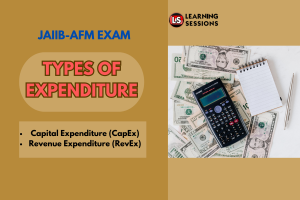The Junior Associate of Indian Institute of Bankers (JAIIB) examination prepares banking professionals with in-depth knowledge of banking operations, accounting principles, and financial management. The Accounting and Financial Management for Bankers (AFM) module covers topics significant for a banker’s day-to-day responsibilities, including Types of Expenditure. Learning Sessions brings this article that explores the importance of knowledge about the types of expenditures in banking and provides a structure for tackling case studies on this topic, focusing on real-world applications and key concepts.

📚 JAIIB Study Resources 📚
👉 Check Here
👉 Check Here
👉 Check Here
👉 Get Tests Here
👉 Check Here
DOWNLOAD PDF TYPES OF EXPENDITURE -CASE STUDY
Expenditure refers to the costs incurred by a business or organization in its operations. In the context of banking, expenditures can be broadly classified into two categories:
-Capital Expenditure (CapEx): Long-term investments made by the bank to acquire or improve fixed assets, such as buildings, technology, and equipment. These expenditures are capitalized and reflected in the balance sheet.
Example: Purchasing new software for improved digital banking services.
-Revenue Expenditure (RevEx): Costs incurred for day-to-day operations that are charged directly to the income statement. These expenditures do not create long-term assets.
Example: Salaries paid to employees or interest paid on deposits.
For the extensive preparation of candidates, get details through our YouTube videos for JAIIB AFM Module wise Syllabus with explanations and tips to help candidates in their preparation journey.
You may also like these JAIIB case studies:
JAIIB | AFM | COMPONENTS OF BALANCE SHEET
JAIIB | AFM | FINANCIAL DECISIONS IN A FIRM
For JAIIB aspirants, differentiating between these two types and understanding their implications on a bank’s financial statements are crucial.
For banking professionals, a clear understanding of expenditures is necessary to manage resources effectively and ensure financial compliance. It aids in:
- Strategic Planning: Balancing long-term investments with operational needs.
- Budgeting and Forecasting: Allocating funds appropriately between capital and revenue expenditures.
- Regulatory Compliance: Ensuring accurate financial reporting as per accounting standards.
- Profitability Analysis: Evaluating the impact of expenditures on profitability and growth.
In general it can be said that, In banking, distinguishing between capital and revenue expenditures can influence strategic decisions such as branch expansions, technology upgrades, and customer service enhancements. By understanding this topic, JAIIB candidates not only succeed in exams but also gain valuable vision for their professional growth. Learning Sessions provides additional information about JAIIB AFM LIQUIDITY RATIO by giving examples of real life scenarios.
Learn more about this case study through our YouTube channel and PDF.
Get access to our Telegram Channel for free Pdfs of JAIIB.







